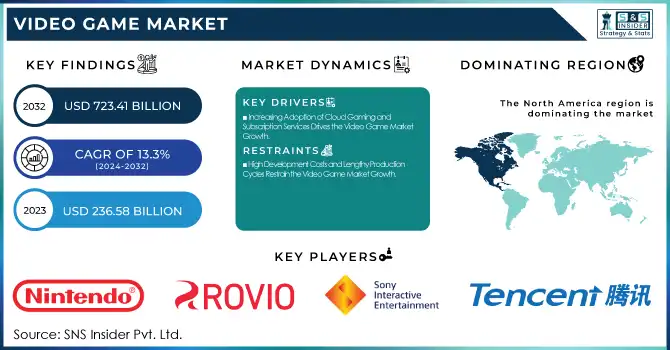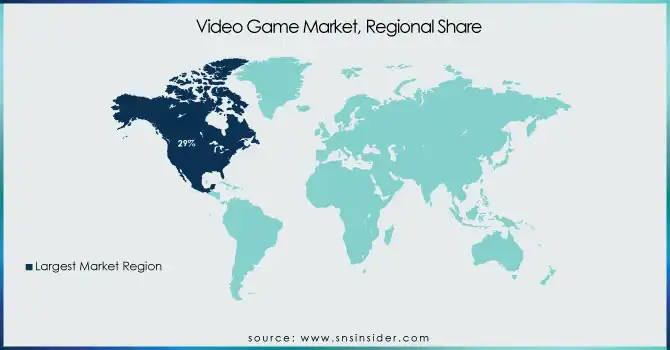Video Game Market Report Scope & Overview:
The Video Game Market Size was valued at USD 236.58 Billion in 2023 and is expected to reach USD 723.41 Billion by 2032 and grow at a CAGR of 13.3% over the forecast period 2024-2032. The various statistical insights offer a deeper understanding of the video game market. The demographic analysis covers the age, gender, and income distribution of gamers. Player engagement metrics track playtime, retention, and in-game purchases. Revenue distribution spans platforms, game types, and monetization models. Esports and streaming statistics highlight audience growth and tournament earnings. Developer data includes active studios and indie trends. Hardware trends cover console sales and cloud gaming adoption. Consumer spending, market penetration, and genre popularity reflect industry demand. Employment data showcases workforce growth, providing key insights into industry trends and opportunities.

To get more information on Video Game Market - Request Free Sample Report
Video Game Market Dynamics
Key Drivers:
-
Increasing Adoption of Cloud Gaming and Subscription Services Drives the Video Game Market Growth
The rising popularity of cloud gaming and subscription-based services is significantly driving the growth of the video game market. Platforms like Xbox Game Pass, PlayStation Plus, and NVIDIA GeForce Now allow gamers to access a vast library of games without the need for expensive hardware. This model reduces entry barriers, making gaming more accessible to a wider audience.
Additionally, cloud gaming eliminates the need for frequent hardware upgrades, enabling players to enjoy high-quality gaming experiences on lower-end devices. With the expansion of 5G and improved internet infrastructure, streaming games seamlessly is becoming more feasible, further fueling adoption. Subscription models provide recurring revenue for developers and publishers, ensuring sustainable growth. Companies are investing heavily in cloud technology, enhancing game performance and reducing latency. As digital distribution continues to replace physical sales, cloud gaming, and subscription services will play a crucial role in shaping the future of the video game industry.
Restrain;
-
High Development Costs and Lengthy Production Cycles Restrain the Video Game Market Growth
The video game industry faces significant challenges due to rising development costs and extended production timelines, restricting market growth. Modern games require advanced graphics, complex storylines, and immersive gameplay, necessitating substantial investment in technology, talent, and marketing. AAA titles can take several years to develop, increasing financial risks for developers and publishers. Delays in production and post-launch updates further escalate costs, impacting profitability.
Moreover, consumer expectations for high-quality content continue to rise, pressuring studios to invest heavily in innovation and optimization. Indie developers, despite creative ideas, often struggle to compete due to budget constraints. Additionally, unexpected challenges such as software bugs and market fluctuations can lead to costly delays or even cancellations. With development costs surging and production cycles becoming longer, only well-funded studios can afford to release high-budget games consistently, limiting opportunities for smaller developers and creating financial risks in an increasingly competitive market.
Opportunities:
-
Expansion of Virtual Reality (VR) and Augmented Reality (AR) Creates Lucrative Opportunities in the Video Game Market
The growing adoption of Virtual Reality (VR) and Augmented Reality (AR) is creating significant opportunities in the video game market. Advances in VR headsets, motion tracking, and haptic feedback are enhancing immersive gaming experiences, attracting both casual and hardcore gamers. Companies like Meta, Sony, and HTC are investing in next-generation VR devices, expanding the market potential. AR-based mobile games, such as Pokémon GO, have demonstrated the potential for interactive gaming in real-world environments, driving demand for AR technology.
Additionally, the integration of VR and AR in cloud gaming and esports is opening new revenue streams for developers. The rising affordability of VR headsets and AR-enabled smartphones is making these technologies more accessible. As 5G networks improve latency and streaming capabilities, VR and AR adoption will accelerate further. The expansion of VR and AR gaming presents significant growth opportunities for developers, hardware manufacturers, and content creators in the evolving video game industry.
Challenges:
-
Cybersecurity Threats and Data Privacy Concerns Pose Challenges for the Video Game Market Growth
Cybersecurity threats and data privacy concerns present significant challenges to the growth of the video game market. With the increasing digitization of gaming, cyberattacks, data breaches, and account hacking have become major risks for players and developers. Online multiplayer games, cloud gaming platforms, and digital marketplaces store vast amounts of user data, making them prime targets for hackers. Unauthorized access to gaming accounts, financial fraud, and identity theft negatively impact consumer trust and can lead to financial losses for companies.
Additionally, concerns over in-game microtransactions and data collection practices have raised regulatory scrutiny, prompting stricter data protection laws. Game publishers must invest in robust security measures, such as encryption and multi-factor authentication, to safeguard user information. However, implementing stringent security protocols can increase operational costs and potentially impact user experience. As cyber threats evolve, maintaining a secure and privacy-compliant gaming environment will remain a key challenge for industry players.
Video Game Market Segments Analysis
By Device
The Mobile gaming segment accounted for the largest revenue share of 42% in 2023, fueled by the widespread adoption of smartphones, affordable internet access, and the growing popularity of mobile gaming apps. Major companies such as Tencent, Activision Blizzard, and miHoYo continue to dominate the market with high-grossing titles like Honor of Kings, Call of Duty: Mobile, and Genshin Impact.
In 2023, Apple introduced new hardware enhancements in the iPhone 15 series, featuring an improved GPU for better gaming performance, while Qualcomm launched the Snapdragon 8 Gen 3 chipset optimized for high-frame-rate mobile gaming.
Additionally, the expansion of cloud gaming services, including Microsoft’s Xbox Cloud Gaming and NVIDIA’s GeForce Now, is allowing users to play console-quality games on mobile devices, further boosting market growth.
The Console gaming segment is experiencing the highest growth rate, with a projected CAGR of 14.9% during the forecast period, driven by advancements in gaming hardware and exclusive game titles. Sony and Microsoft continue to lead with the PlayStation 5 and Xbox Series X|S, which offer superior graphics, faster load times, and high-performance capabilities.
In 2023, Sony introduced new PlayStation 5 variants, including a slimmer model with an optional detachable disc drive, while Microsoft expanded its Xbox Game Pass subscription service, enhancing digital gaming experiences.
By Type
The Online gaming segment held the largest revenue share in 2023, driven by the rapid expansion of cloud gaming, multiplayer experiences, and the increasing shift toward digital game distribution. Major industry players such as Microsoft, Sony, and Tencent have strengthened their online gaming presence through innovative platforms and services. Microsoft expanded its Xbox Cloud Gaming service, allowing players to stream high-quality games without the need for powerful hardware.
Sony enhanced PlayStation Plus, integrating cloud gaming features and a growing library of multiplayer games. Tencent continued its dominance in online gaming with titles like Honor of Kings and PUBG Mobile, leveraging live-service models and frequent content updates.
Additionally, Epic Games and Valve expanded their online storefronts, reinforcing digital game sales through platforms like the Epic Games Store and Steam. The rise of esports, in-game purchases, and cross-platform multiplayer functionalities further fueled online gaming adoption. As 5G networks improve connectivity and cloud infrastructure advances, online gaming is expected to maintain its dominance, shaping the future of the video game market.
Regional Analysis
North America led the global video game market in 2023, holding an estimated market share of 29%, driven by strong consumer spending, advanced gaming infrastructure, and the presence of major industry players. Companies like Microsoft, Sony, and Electronic Arts (EA) continue to drive market dominance with successful game franchises, console sales, and digital services. Microsoft’s Xbox Game Pass has gained significant traction, offering a vast library of games on a subscription basis, while Sony’s PlayStation 5 remains one of the best-selling consoles in the region.
Additionally, the North American audience has a high preference for premium AAA games, with titles such as Call of Duty: Modern Warfare III and The Legend of Zelda: Tears of the Kingdom generating record-breaking sales. Strong adoption of new gaming technologies and digital monetization models solidifies North America’s leading position.
The Asia Pacific region is experiencing the highest growth in the video game market, with an estimated CAGR of 14.8%, driven by increasing smartphone penetration, rising esports popularity, and government support for gaming industries. Countries like China, Japan, and South Korea are at the forefront, with companies such as Tencent, NetEase, and Nintendo leading the market.
Additionally, the Indian gaming sector is booming due to the affordability of smartphones and the increasing popularity of mobile esports. With rising disposable incomes, evolving gaming habits, and government-backed gaming initiatives in countries like China and South Korea, the Asia Pacific region is poised for continued rapid expansion.

Get Customized Report as per Your Business Requirement - Enquiry Now
Key Players
Some of the major players in the Video Game Market are:
-
Nintendo (Nintendo Switch, The Legend of Zelda: Tears of the Kingdom)
-
Rovio Entertainment Corporation (Angry Birds 2, Angry Birds Boom!)
-
Sony Interactive Entertainment Inc. (PlayStation 5, God of War: Ragnarok)
-
Tencent Holdings Ltd. (Honor of Kings, PUBG Mobile)
-
Activision Blizzard (Call of Duty: Modern Warfare III, Diablo IV)
-
Apple Inc. (Apple Arcade, App Store Gaming Platform)
-
Disney (Disney Dreamlight Valley, Marvel’s Spider-Man 2)
-
Electronic Arts Inc. (FIFA 24, Apex Legends)
-
Lucid Games (Destruction AllStars, Switchblade)
-
Microsoft Corp. (Xbox Series X, Halo Infinite)
Recent Trends
-
September 2024: Rovio Entertainment, in collaboration with Play Mechanix and Raw Thrills, unveiled "Angry Birds Boom!", a new arcade game designed for family entertainment centers. The game features a 65-inch interactive LED display and allows up to two players to launch characters into destructible environments filled with adversaries. Attendees at the IAAPA Expo Europe in Amsterdam previewed the game, with global shipments commencing in late October.
-
January 2025: Microsoft announced plans to port select Xbox titles, including "Microsoft Flight Simulator 2024" and "Halo: The Master Chief Collection," to Nintendo's upcoming Switch 2 console. Phil Spencer, head of Microsoft's gaming division, expressed enthusiasm for supporting Nintendo's new platform. Further details are anticipated during Nintendo's "Nintendo Direct" event on April 2.
| Report Attributes | Details |
|---|---|
| Market Size in 2023 | US$ 236.58 Billion |
| Market Size by 2032 | US$ 723.41 Billion |
| CAGR | CAGR of 13.3 % From 2024 to 2032 |
| Base Year | 2023 |
| Forecast Period | 2024-2032 |
| Historical Data | 2020-2022 |
| Report Scope & Coverage | Market Size, Segments Analysis, Competitive Landscape, Regional Analysis, DROC & SWOT Analysis, Forecast Outlook |
| Key Segments | • By Device (Console, Mobile, Computer) • By Type (Online, Offline) |
| Regional Analysis/Coverage | North America (US, Canada, Mexico), Europe (Eastern Europe [Poland, Romania, Hungary, Turkey, Rest of Eastern Europe] Western Europe] Germany, France, UK, Italy, Spain, Netherlands, Switzerland, Austria, Rest of Western Europe]), Asia Pacific (China, India, Japan, South Korea, Vietnam, Singapore, Australia, Rest of Asia Pacific), Middle East & Africa (Middle East [UAE, Egypt, Saudi Arabia, Qatar, Rest of Middle East], Africa [Nigeria, South Africa, Rest of Africa], Latin America (Brazil, Argentina, Colombia, Rest of Latin America) |
| Company Profiles | Nintendo, Rovio Entertainment Corporation, Sony Interactive Entertainment Inc., Tencent Holdings Ltd., Activision Blizzard, Apple Inc., Disney, Electronic Arts Inc., Lucid Games, Microsoft Corp. |

